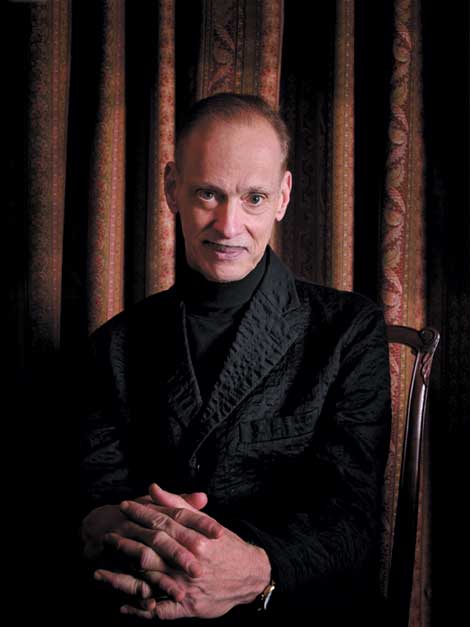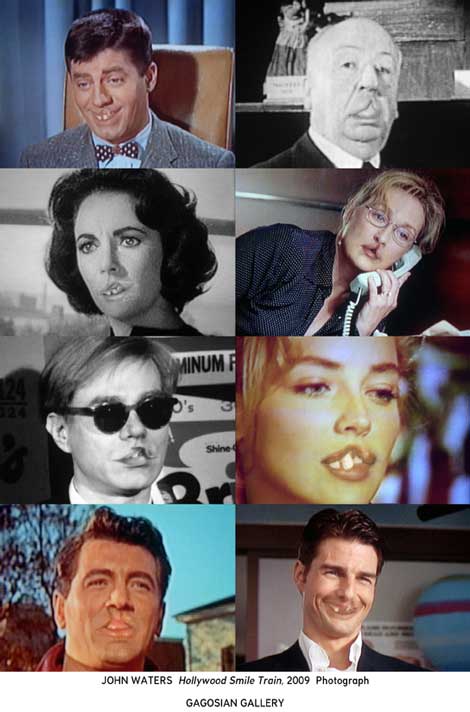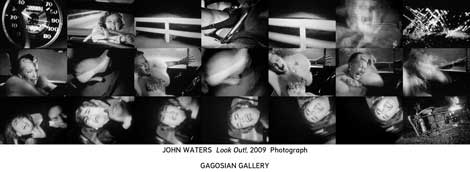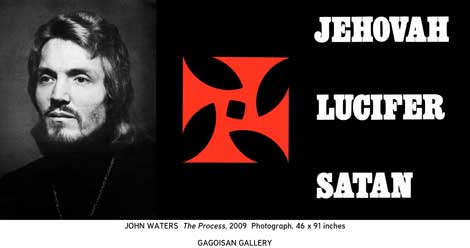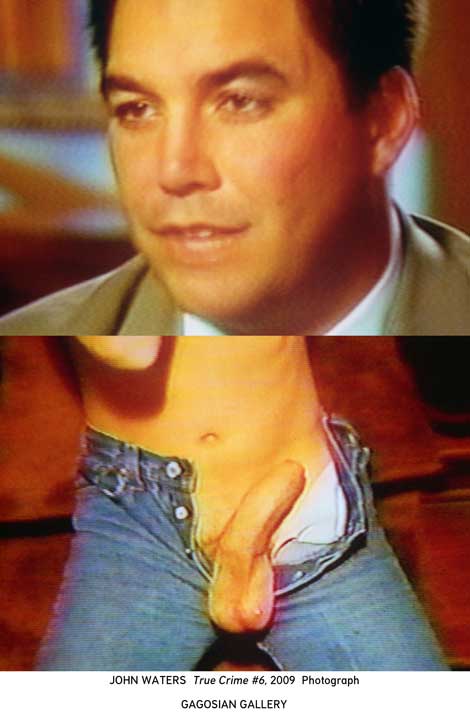Waters once said, “To understand bad taste one must have very good taste.” And after seeing his place in San Francisco, I would have to say he practices what he preaches. Antique furniture, tapestries and decorative drapery adorn the small but elegant 1920s apartment in Nob Hill. Bookshelves line the walls. Very tasteful art (okay, some not so tasteful) hangs on the walls and fills every nook and cranny. He has to stash the bag of rocks by Paul Lee when the maid comes, so she won’t mistake it for rubble. And he has to hide his Richard Baker pill art when his ex-junkie friends visit.
But I’m not here to check out Waters’ pad, nor his art collection — I’m here to talk about his art, and his two solo shows with Gagosian in Los Angeles and Marianne Boesky Gallery in New York, both happening in April. “Rear Projection” is the title and on the announcement card is a pair of buttocks with a film projected on them. Get it? Waters explained that it’s a term for the fake moving scenes behind actors on film sets, mainly when the characters are driving. He’s always loved them, and of course, there’s the pun. That John!
Known first as an underground filmmaker in the ’70s, Waters has been making and showing art since the ’90s. And now, he’s with the most famous and powerful art dealer in the world — Larry Gagosian. This will be his first show with Gagosian, and he’s been with Marianne Boesky for three years. Waters says, “People were incredibly suspicious when I had my first art show.” A lot of people, mainly artists, are dubious of celebrities who suddenly come out and say: Oh, you didn’t know I paint too? Waters wanted to make sure I knew that his status in the film world did not pave the road for easy access into the art world and that he keeps both worlds very separate.
It was Colin de Land, from American Fine Art gallery, who gave Waters his first show back in 1992. De Land approached Waters and asked him if he made art. It just so happened the filmmaker had an entire body of artwork at the time. He had been photographing film scenes from movies, then pasting them together out of context.
“I could never really have gone as far as I have without Colin de Land,” Waters says with heartfelt gratitude. “But because it was at American Fine Art, probably THE most respected cutting-edge gallery — and most of the time there was nothing for sale — it kind of protected me as much as it could from that. So I owe Colin a great, great part of my entrée into the art world.”
A black vinyl binder sits prominently on the dinner table that takes up the entire dining room. We sit around it. He opens it up and it’s full of reproductions of his recent work. The images are in clear plastic folders that he flips through excitedly. He skips from image to image, then topic to topic and we find ourselves talking about the Mansons or the religious cult the Process — also the title of one of his pieces. Waters has been to their chapel in New Orleans and speaks wildly about them, as if possessed: “The Process [is a cult] others have said the Mansons copied. They worship Christ and the Devil. If there ever was a cult I would have joined, it would have been the Process.” I watch Waters with amazement, how he truly gets excited about such things, and then when I’m just about to sign on the dotted line, he pauses, gets serious, and shyly admits the real reason he’s into them: “They wore cloaks.”
His famous Cheshire cat grin appeared. I was waiting for it. It’s that mystery about Waters that keeps most of his fans going. Is he for real? Is it all a joke? One thing’s for sure: When you’re having a solo show with Larry Gagosian, it’s no joke.
Both shows will be crammed with photograph collages and sculptures too. We stop at an image of a giant night cream jar — a product Waters uses that costs $200. Waters calculated that it would cost more than $800,000 if the cream were to fill the sculpture. (He didn’t make it clear if that was the price of the piece.) All the sculptures are influenced by Pop art, and are, frankly, hilarious. There’s an oversized roach motel and a huge poppers jar, “I’m a fan of poppers, I always have been,” Waters quips.
So where does Waters find the time to do all this? “It’s not like Ghost, where I’m at a pottery wheel,” he pointed out. Waters has a staff working for him. It’s no more than a handful of people, but it’s a staff nonetheless. And he is rigid with his schedules. He has organized his time to set aside days for each of his many media. He’s currently working on a book, so one day might be his writing day. He has “art days” when he goes into the studio and works all day on just art. “Rear Projection” has been in the works for two years. He starts every day the same, Monday through Friday. Gets up at 6 a.m., reads his newspapers, drinks tea. He works on his projects from 8 a.m. until noon. Then from noon until the end of the day, he deals with the business end of things.
One of his art days might consist of a day in the studio with his remote, stopping and starting the beginning of a blood-curdling scream of a blonde in a ’50s Oldsmobile convertible, with her stilettos pressed against the brakes, heading for a crash. One such piece, titled Look Out!, consists of movie scenes where the damsel in distress is the focus. By zeroing in on that horrific moment, Waters manages to make the viewer laugh, to make that scene suddenly camp (even though a lot of the films he picks border on camp) — and something he apparently has down. He uses a 35mm film camera to shoot the movie scene from video, then has it developed; he prefers low-tech. Waters notes his process is “about editing, and film knowledge, and hopefully, it’s about humor. Which is what all my work is about, no matter what field. It is based on some kind of insider knowledge of the ridiculousness of being in show business.”
Most of the work can be traced to Hollywood, but some is about art. I wonder if Waters taps into the ridiculousness of that business as well? “I find the extremes of the art world
hilarious. You can’t open it up to regular people — THEY HATE IT!” he screams. Waters then excitedly shows me a piece in which the text reads, “Contemporary Art Hates You.” “It does!” he cries. “They can’t learn to SEE! That piece of art on the wall DOES hate them, and I find that delightful. It’s a business that only a few people can see the magic trick. And if you can really do it, like Mike Kelley can — an old rag on the floor, and turn that into a piece in a museum — THAT IS WHAT ART IS! About being a magician. So the people are mad before they look at it. Because it makes them feel stupid. And they are!”
Waters is always one step ahead of you. He’s unpredictable, and he makes an art of it. What might be considered shocking, Waters will find tame, borderline boring. If it’s something mundane, he’ll be thrilled and deem it outrageous. He refuses to be pigeonholed. So is he just a contrarian? Not always, which I guess means yes.
“I’m not against all the things that most people get mad about [with] art. And I always say to artists that hate rich people, ‘Well, that’s stupid. Who’s going to buy your work?’ It’s not like Obama is giving out art stamps! So, I’m always amazed at that. How can you hate rich people?” And that goes for the artists, too. Waters thinks an artist can never be too rich. “Good for them. I’m happy for them. I never understand resentment about that. Good for you! You thought this up. Who would complain about that?”
We keep flipping through his art folder. There seems to be a theme, certain eras in the movies, then there’s a giant roasted ham. It’s big, it’s sumptuous, it’s Easter Sunday. But to Waters that image stands for the movie actor who is a ham, a visual pun for bad acting. “It’s a very negative review, and I celebrate that a lot,” he joyfully explained.
He also celebrates Catholicism with his piece Catholic Sin, where there’s a diagram of three milk bottles depicting the difference between mortal and venial sins. Milk bottles measuring the souls of Catholics — a diagram straight from one of his Catechism books. Next is a picture of a mildly handsome ’80s guy’s face juxtaposed against a picture of a large erect penis. Turns out it’s the face of infamous wife-killer Scott Peterson and a generic porno cock. It’s called, True Crime. Waters riffs on “the unspoken thing, that people think serial killers are hot.”
Waters’ early films can be considered subversive, but the director begs to differ. “If any movie I’ve ever done was subversive, it would be Hairspray, because regular families watched it, not realizing it encouraged their children to date black people.” He says this in all seriousness and continues, “All contemporary art is supposed to be subversive. It’s supposed to wreck what came before. It’s supposed to damage and change what people think of as fine art. So I guess if you can think of something new, that is subversive, and that is what everybody in the contemporary art world is trying to do. That’s their job.”
Hollywood Smile Train is one piece of Waters’ that I would call subversive, or at the very least, galling. Waters explained the inspiration behind applying cleft palates to movie stars’ faces. It came from the numerous billboards and magazine ads of these unfortunate children. “I’m always suspicious of charities that have HUGE advertising budgets. I’m not so sure [how much] that child with the cleft palate got. As much as they advertise, I have a right to make fun of it.” Waters admits that it is probably the most tasteless piece in the show. But maybe more than poor taste, or subversive, it’s just nervy.
Waters loves nerve. “I love when the art says, ‘It’s finished.’ And you got nerve, to show it to the dealer, then show it to world, and then show it to the collectors. And I love to see groups of collectors, because they’ll never admit that it’s too far for them. That’s what starts the next movement. I love to see that thin line, when… Oh, come on … OH COME ON! … is what I end up liking the best. It’s extreme. It’s supposed to be extreme. I respect extremity, even if I don’t agree with it.”
Extremity in the First Degree — I think Waters has been guilty of that from the very beginning. And he practices it to this day. Even though he doesn’t think shock value “works anymore and is old-fashioned,” I still think he’s capable of coming up with some pretty provocative material. His thoughts on art are anything but old-school, and they might still be called subversive, even today. But I sort of get what he means. He’s so polite and well-mannered that it just seems seditious. The homespun needlepoint throw pillow on his couch — it adds a touch of comfort. And to know his mother made it for him, well, that’s just touching. BUT IT’S A PICTURE OF A POLICE CAR IN FLAMES! That John!
See John Waters: “Rear Projection” at Gagosian Gallery, Beverly Hills, April 11 – May 23, 2009 and at Marianne Boesky Gallery, New York City, April 3 – May 2, 2009.

